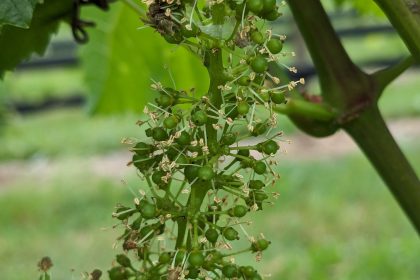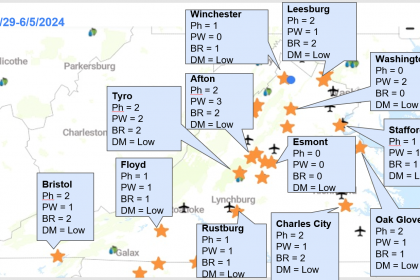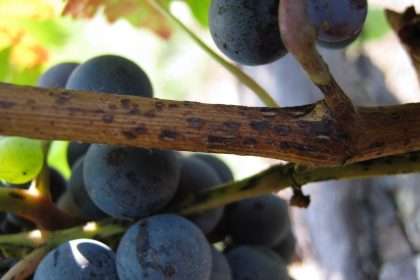Now the season is wrapping up, and one of questions I get often is “when to spray what to protect your crop at the last stretch”. Unfortunately (as with everything else), my answer to the question is “it depends.” But it won’t help anybody, so, let’s go over several potential scenarios and see one of them makes sense to you.
Case 1: you are expecting harvest in 2-3 weeks
I think many of Chardonnay and other early white cultivars are about to be harvested. Luckily, around Winchester area, we have had a good stretch of relatively dry weather. We had rain showers came in several times, but only two of them, one at 8/4 and another one on 8/20 were long enough to initiate major late season diseases, such as Botrytis. We have three Botrytis trials, but we have not seen evidence of Botrytis outbreak. Moreover, at Winchester area, a forecast of next rain is on next Tuesday, and it looks like a case of another thunderstorm.
Thus, at this point, only concern I have is powdery mildew, and maybe Botrytis and sour rot. For the powdery mildew, it may show up on the upper part of the canopy where young foliage is available; however, it won’t affect your berries at this point of the season. It will take at least a week from infection to the production of spores, so, with 2-3 weeks to go, it is less likely to see powdery mildew being a big issue for our harvest.
As I noted earlier in this blog, the first line of defense against Botrytis and sour rot is a good canopy management, and management of insects (e.g., grape berry moth) and birds that can cause wounds on berries. If you have been successful on these, there are low chances of getting into trouble at this point. Even if there are some Botrytis, with the dry days in the forecast, I am not sure how much damages can Botrytis cost, unless of course, you have not keep up with canopy management. Botrytis really likes humidity that can be created by a poorly managed dense canopy.
So, what to do? If you have not seen any sign of powdery, Botrytis, and sour rot issues with your vines, I may say that you probably do not need to worry about applying another fungicides, unless there is a tropical storm coming up from the south (it does not look like it as of today). But if you are concerned about powdery or Botrytis based on the current status or the history of your vineyard, it is probably better to apply something before the Tuesday’s expected rain. For the specifics, please refer to the end of this posting.
Case 2: You still have more than 4 weeks to go.
Many of reds probably still have at least 4 weeks to go. In addition to powdery mildew and Botrytis, downy mildew can become an issue. As temperature during the night goes down, the relative humidity goes up. This humid dark condition stimulates downy mildew pathogen to produce spores. Young leaves are more susceptible to downy mildew infection; thus, you will see the development of late season downy mildew at the top part of the canopy. If it stays in the upper canopy, I do not see any major threats; however, things can go bad if we have many rain events and even more resistant older leaves become infected. Although berries are resistant to downy mildew infection at this point, heavy infection on foliage can result in defoliation.
There are concerns on the effect of certain fungicides, such as copper, captan, and sulfur on fermentation or quality of wine. Thus, often time wine makers do not want to see the use of these chemicals within a month of harvest. Thus, if you want to have a last shot of these fungicides, next week or so might be the best timing.
Since there are more weeks to go, what I would recommend is use of good downy and powdery mildew materials in the near future to keep foliage clean, and use Botrytis material as needed (i.e., if a tropical storm is coming up north).
Case 3: You have on-going disease issue(s)
Some of you might have been having a difficulty containing some of diseases, and hoping to get something out from the bad situation. Due to concerns on fungicide resistance, what we typically recommend is the use of relatively low fungicide resistance risk materials. Copper, captan, and phosphorous acid (Prophyt etc., but tank mix with other downy mildew material) for downy mildew, sulfur, potassium bicarbonate, and (Kaligreen, Armicarb, etc.), and stylet oil (use with a caution: no oil spray within two weeks of sulfur or captan spray!) for powdery mildew, and copper and captan for Botrytis. Also, make sure to contact your local extension agents and/or attend one of our IPM meetings so that you will have a better plan for next season.
Select list of materials and their PHIs
Powdery mildew: DMIs (Rally, Elite, Luna Experience, etc.), Quintec, and Vivando, have 14-day PHI, Torino has 3-day PHI, and sulfur has 0-day PHI
Downy mildew:Revus, Revus Top, and Adament (need to be tank-mixed with captan or copper or Phosphorous acid) have 14-day PHI. Revus has a very good protective activity against downy mildew; thus, it could come in handy this time of the season. Unfortunately other good downy material has longer PHIs. Phosphorous acid (Prophyt, Phostrol, etc.), captan, and copper have 0-day PHI.
Botrytis: SDHIs (Luna Experience and Tranquility, Pristine (note: Pristine and Eudura have higher risk of resistance development), etc.) and Inspire Super have 14-day PHI. Scala, Meteor (= Rovral), Switch, and Vanguard have 7-day PHI, and Elevate has 0-day PHI. (Note: canopy and bird management are very important too!)
Ripe rot and bitter rot: QoIs (Abound, Flint, etc., PHI=14 days) and captan have a good efficacy. Please make sure to rotate between them.






Once again, excellent and reassuring advice – thanks!